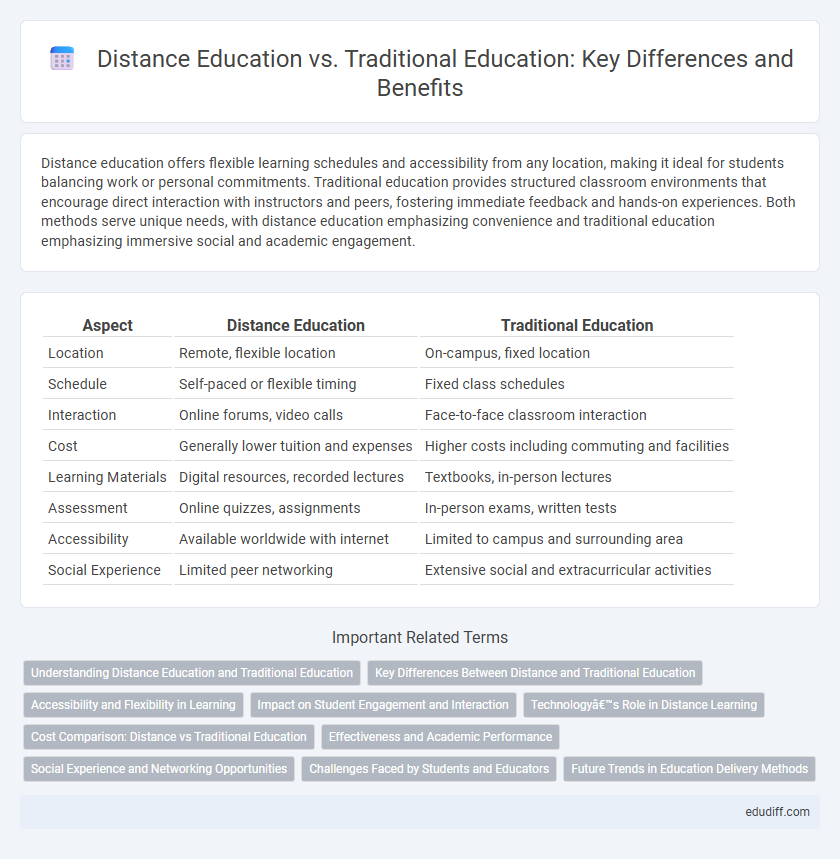Distance education offers flexible learning schedules and accessibility from any location, making it ideal for students balancing work or personal commitments. Traditional education provides structured classroom environments that encourage direct interaction with instructors and peers, fostering immediate feedback and hands-on experiences. Both methods serve unique needs, with distance education emphasizing convenience and traditional education emphasizing immersive social and academic engagement.
Table of Comparison
| Aspect | Distance Education | Traditional Education |
|---|---|---|
| Location | Remote, flexible location | On-campus, fixed location |
| Schedule | Self-paced or flexible timing | Fixed class schedules |
| Interaction | Online forums, video calls | Face-to-face classroom interaction |
| Cost | Generally lower tuition and expenses | Higher costs including commuting and facilities |
| Learning Materials | Digital resources, recorded lectures | Textbooks, in-person lectures |
| Assessment | Online quizzes, assignments | In-person exams, written tests |
| Accessibility | Available worldwide with internet | Limited to campus and surrounding area |
| Social Experience | Limited peer networking | Extensive social and extracurricular activities |
Understanding Distance Education and Traditional Education
Distance education leverages online platforms and digital resources to deliver flexible learning experiences beyond physical classrooms, enabling access for diverse student populations. Traditional education emphasizes face-to-face interaction, structured schedules, and hands-on activities within established institutions, fostering direct social engagement and immediate feedback. Understanding these modalities highlights how distance education prioritizes accessibility and self-paced study, while traditional education focuses on in-person mentorship and campus community involvement.
Key Differences Between Distance and Traditional Education
Distance education offers flexible scheduling, allowing students to access course materials and participate in learning activities from any location via online platforms, contrasting with traditional education's fixed classroom hours and physical attendance requirements. Interaction in distance education primarily occurs through digital communication tools such as discussion forums and video conferencing, whereas traditional education emphasizes face-to-face engagement and immediate instructor feedback. Assessment methods in distance education often incorporate online quizzes and remote submissions, differing from traditional education's in-person exams and controlled testing environments.
Accessibility and Flexibility in Learning
Distance education offers unparalleled accessibility by allowing students to learn from any location, eliminating geographical barriers that often restrict traditional education. Flexible scheduling in distance education accommodates diverse lifestyles and commitments, enabling learners to balance studies with work or family responsibilities. Traditional education, while providing structured environments and face-to-face interaction, often lacks the adaptive flexibility inherent in online or remote learning platforms.
Impact on Student Engagement and Interaction
Distance education leverages digital platforms to create interactive learning environments that can increase student engagement through multimedia content and real-time communication tools. Traditional education offers in-person interactions that facilitate immediate feedback and spontaneous discussions, fostering deeper social connections and collaborative learning. Research shows that while distance education enhances flexibility, traditional settings often yield higher levels of active participation and peer engagement due to face-to-face dynamics.
Technology’s Role in Distance Learning
Technology plays a pivotal role in distance learning by enabling interactive platforms, real-time communication, and access to vast educational resources that traditional education may lack. Advanced tools such as video conferencing, digital whiteboards, and learning management systems enhance engagement and provide personalized learning experiences for students. The integration of artificial intelligence and virtual reality further transforms distance education, offering immersive and adaptive learning environments that rival conventional classroom settings.
Cost Comparison: Distance vs Traditional Education
Distance education typically offers lower overall costs due to reduced expenses in commuting, housing, and textbooks, often utilizing digital resources and online platforms. Traditional education generally incurs higher tuition fees and additional costs such as campus facilities, transportation, and on-site living expenses. Cost comparison studies indicate that distance education provides a more affordable alternative without compromising program quality, especially for non-traditional students balancing work and family commitments.
Effectiveness and Academic Performance
Distance education offers flexible learning schedules and access to diverse digital resources, which can enhance academic performance for self-motivated students. Traditional education provides face-to-face interaction and structured environments that often improve engagement and effectiveness for learners benefiting from direct supervision. Research indicates comparable academic outcomes when instructional quality and student support are maintained across both modalities.
Social Experience and Networking Opportunities
Distance education often limits face-to-face interactions, reducing spontaneous social experiences and in-person networking opportunities. Traditional education provides structured environments like classrooms and campus events that foster social bonding and professional connections. Students in physical settings benefit from immediate feedback, group activities, and networking that support career development.
Challenges Faced by Students and Educators
Distance education presents challenges such as limited face-to-face interaction, which can hinder real-time feedback and social engagement crucial for effective learning. Educators often struggle with adapting teaching methods and assessing student performance without physical presence, impacting instructional quality. Students face issues with self-motivation, time management, and access to reliable technology, which can create disparities in educational outcomes compared to traditional settings.
Future Trends in Education Delivery Methods
Distance education leverages advanced technologies like AI-driven platforms and virtual reality to create immersive, personalized learning experiences that transcend geographical barriers. Traditional education is increasingly integrating hybrid models combining in-person instruction with online resources to enhance flexibility and accessibility. Future trends emphasize adaptive learning systems, data analytics for student performance, and expanded use of mobile learning, reshaping education delivery methods worldwide.
Distance education vs Traditional education Infographic

 edudiff.com
edudiff.com